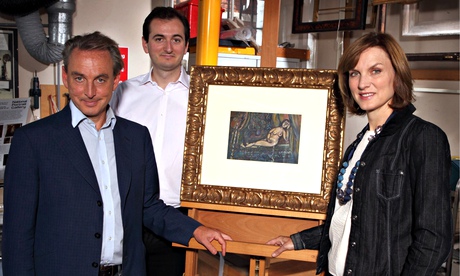The man whose ‘real Chagall’ could now be burnt as a fake
Leeds man hoped a BBC art show would verify his painting, but now France plans to destroy it

The painting, Nude 1909-10, attributed to Marc Chagall, on Fake or Fortune with (l-r) Philip Mould, Bendor Grosvenor and Fiona Bruce. Photograph: BBC/Glenn Dearing
When a Yorkshire businessman bought a reclining nude attributed to Marc Chagall for £100,000, he hoped the painting would provide a tidy nest-egg for his family. Instead, 20 years later, he faces the prospect of watching his sizeable investment being burnt in front of a French magistrate.
Martin Lang, 63, from Leeds, bought Nude 1909-10, which was “attributed to Chagall” in 1992, on the advice of a Russian art dealer who also worked for a major auction house. Chagall, who died in 1985, was a Russian-French pioneer of modern art, revered by collectors worldwide. One of his paintings recently sold for $10m.
After watching last year’s series of the BBC art programme Fake or Fortune?, Lang volunteered his “Chagall” to the programme’s producers for scrutiny, citing its reproduction in an art book by a Soviet art expert and friend of Chagall.
It turned out to be a bad move. As research began to cast doubt on the provenance of Lang’s painting, complex paint analysis showed that the blue and green pigments were too modern, having been developed only in the 1930s. Moreover, a later edition of the Soviet-era publication showed that the reference to Nude 1909-10 had been removed. The work was submitted to the Chagall Committee in Paris, the only authority with the power to declare conclusively whether a work said to be by Chagall is genuine or a forgery. The committee is headed by Chagall’s two granddaughters.
Handing over his painting for examination, Lang signed a contract stating that “Marc Chagall’s heirs could demand the seizure of the work, and/or any other measures stipulated by law”. But it now appears that the committee, which was expressly set up to defend Chagall’s legacy, is determined to destroy the work. An archaic French law provides for the destruction of fakes in front of a magistrate. A proposal that the back of the painting be marked as fake was rejected.
Philip Mould, the art expert used by Fake or Fortune?, condemned such an extreme measure as “barbaric”. “I can’t believe it, actually,” he old the Observer.
He added that the Chagall Committee seems “hell-bent” on destroying the painting, even though fakes have their uses in training the eye to what is genuine: “They are getting back to Mr Lang this week. But, as it stands, this picture will be burned in front of a magistrate.”
Mould said that, although £100,000 is “a big loss” – the original price reflected the fact that the painting had not been formally verified – it would have been worth perhaps £500,000 if it had turned out to be genuine.
The BBC programme reflects a Russian art market in which 90% of works are fakes. Chagall is a particular target for forgers. The committee believes that Lang’s painting is an imitation of the 1911 reclining nude.
Pierre Valentin, a specialist art lawyer, told the programme’s makers that two works purportedly by Joan Miró had been similarly destroyed as fakes. Their owners lost a legal fight and he does not believe that Lang can save the painting, even though he and his family have become attached to the forgery.
Lang said he has no plans to seek a refund on his original purchase: “I lack confidence in the system to give me the results I would be seeking.” He has, however, asked the committee to guarantee that he will be compensated if evidence ever surfaces to prove the picture’s authenticity. He told the Observer: “There’s nothing definite in life. There’s always room for error.”
By Dalya Alberge
Source: http://www.theguardian.com